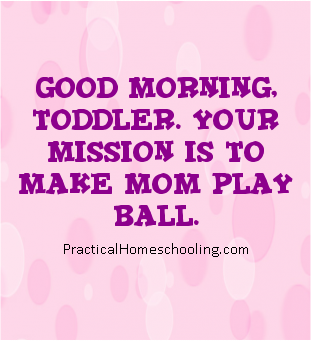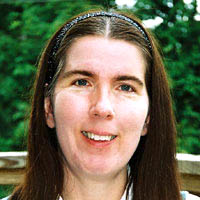Make Mom Play Ball: Physical Education for Tots
By Melissa Morgan
Printed in
Practical Homeschooling #94, 2010.
 What to think about when designing physical education activities for toddlers
What to think about when designing physical education activities for toddlers

| 
|
Good morning, toddler. Your mission is to make Mom play ball. There Mom
is—busy, busy. Her eyes are stuck on the little phone screen, and her
fingers are on the little ticky-tacky buttons. Push the ball—closer,
closer—now—kick it! Bam! The ball hits the ticky-tacky thing, and it
flies across the room. “Look, Mommy!”
 Okay, maybe there’s a better way to make your parent, brother, sister,
grandma or grandpa play ball with you. Let’s look at this from a
grown-up’s point of view.
Okay, maybe there’s a better way to make your parent, brother, sister,
grandma or grandpa play ball with you. Let’s look at this from a
grown-up’s point of view.
According to familyfitness.about.com: “In the late 1970s, about 5% of
children between 2 and 5 years old were overweight. Recently, that
figure has climbed to nearly 14%, according to the Centers for Disease
Control and Prevention.”
Your toddler just wants to play, but there is so much that big people
need to do and so little time to get it done. Parents might have other
concerns, too. What if my child gets hurt? What if I get hurt? (Use your
own best judgment, and clear your exercise program with your family
doctor first.)
Both parents and children reap benefits when they become more physically
active. Active play can aid in children’s mental, social and emotional
development, and it can help parents deal with the stresses of parenting
energetic youngsters.
No need for formal gym class, or for expensive equipment. Past
generations managed to gain manual dexterity and exercise small and
large muscles, often with no more equipment than a ball or jump rope.
Brisk walks can sharpen your mind, and most toddlers will discover
plenty of bugs, cars, trucks, clover, and dandelions to interest them.
To a young child, a walk around the block is a great adventure. Notice
what interests your child, and take the opportunity to find things to
talk about with your little adventurer. As your child talks, take time
to listen closely. Respond in simple words that keep the conversation
going.
Teach your child traditional games to play, like jacks, hopscotch,
marbles and bike riding. You can call this time “gym,” and painlessly
include simple lessons to improve memory skills and safety smarts. On
rainy days, play active indoor video games (like Wii Active Life), dance
to music together, or exercise to library video programs.
Most communities offer opportunities for preschool sports, including
baseball, soccer, tumbling, and tap dancing, through county recreation
departments.
What if you can’t find positive social and physical education outlets
that “click” for you and your toddler, matching your family goals and
values? Homeschool groups and play groups can band together, making Mom,
Dad and older siblings play ball—and much more. Contact your local,
state or national homeschool organization to find a local homeschool
network in your area. (Search for groups at home-school.com/groups.)
Consider starting your own park day or play dates with a few friends.
Parents can take turns sharing skills that they feel comfortable
teaching. You don’t need to be a professional ball player—you just need
to know a little more than your toddler. You already have a height
advantage!
Young children need a lot of hands-on direction. Toddlers often need
practice developing listening skills, and may not yet understand simple
direction words, such as over, under, on, and around. They also need to
learn how to wait their turn, and how to encourage others who may be
smaller, weaker, or have physical or mental challenges.
Often, smaller groups of just a few kids may interact well, while a
larger group can lose control, running around aimlessly. If your goal is
to help your child develop physically and socially, large groups may be
counterproductive, unless there are enough adults or mature teens to
offer guidance and direction. However, getting together with other
families, with adult supervision, can be a positive influence on your
youngster.
You can also take turns at different houses and park locations, sharing
equipment and giving children varied experiences. Consider planning
simple play date activities such as running through the sprinkler, relay
races, homemade obstacle courses with cardboard box tunnels, and
backyard scavenger hunts. For item ideas for object hunts, check out
books from the library, such as “I Spy” books or the “High Five”
Highlights for Children (for age two to six) magazine series.
Find inexpensive sporting equipment at garage sales or resale shops such
as thrift stores and Play It Again Sports. However, use your own
judgment regarding safety. Both old and new equipment carries risk,
especially with small children involved. Remember Murphy’s Law: Anything
that can go wrong will go wrong. Put safety first, and purchase well
made, age-appropriate items such as approved helmets, knee pads, stable
trikes, mini-kick scooters, plastic wiffle balls and fat, lightweight
bats. Easy-to-catch, large, soft rubber balls with knobby surfaces, or
inflatable beach balls make learning to catch “ouchie”-free. The tricky
part is providing just enough supervision and safety, while allowing
room for making mistakes, learning, and growing.
Search for the rules for easy group action games, such as Red
Light/Green Light and Doggy, Doggy, at
www.gameskidsplay.net/games/xtra_games.htm. Consider games that emphasize
cooperation, such as playing Parachute Popcorn. If you don’t have a
parachute, a sheet and small lightweight (plastic or foam) balls will
do. You should have at least one ball per child. All ages can play this
game, but try and balance the heights holding the sheet, with smaller
children evenly interspaced with taller folks. Once every person is
holding the sheet, in a circle, place the balls in the center of the
sheet and “pop” the balls together. The goal is to see how long you can
keep the balls popping, without any flying out! This helps kids learn to
work together as a team; it is harder than it sounds.
Don’t forget to include rest after your tot makes you play ball. A
quiet, wind-down time is important for both of you. Follow your
toddler’s lead—have fun!
Melissa L. Morgan is the co-author of Educational Travel on a Shoestring
and Homeschooling on a Shoestring. With her husband, Hugh, she has
homeschooled their three children from birth, taking advantage of many
educational opportunities in the real world. She invites you to visit
her website at www.eaglesnesthome.com.